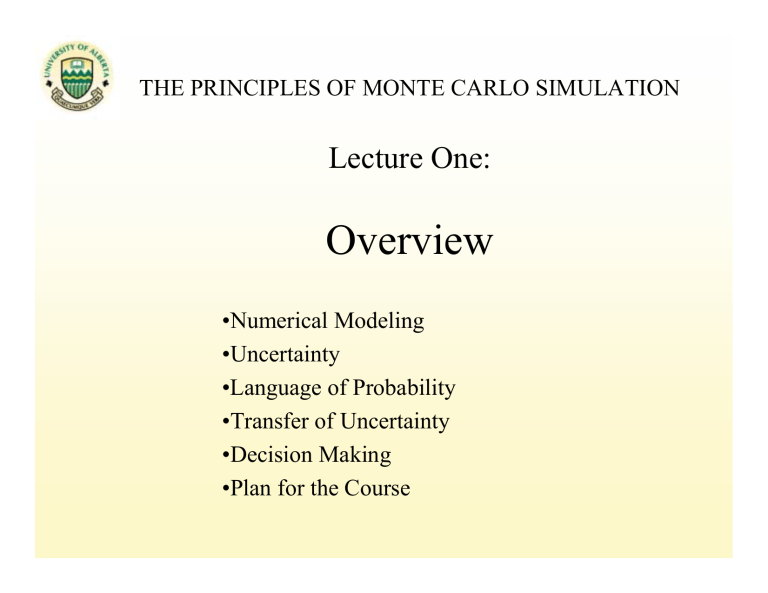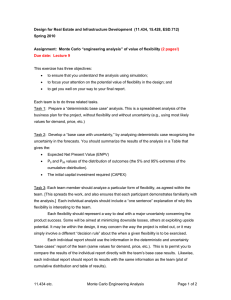
THE PRINCIPLES OF MONTE CARLO SIMULATION Lecture One: Overview •Numerical Modeling •Uncertainty •Language of Probability •Transfer of Uncertainty •Decision Making •Plan for the Course Course Preparation • The course was prepared by the Centre for Computational Geostatistics (CCG), a research group at the University of Alberta • CCG directed by Prof. Clayton V. Deutsch • Course preparation by C. Deutsch team of graduate students: – – – – – – – Oy Leuangthong Hanh Nguyen Karl Norrena Julian Ortiz Bora Oz Michael Pyrcz Stefan Zanon • Excellent first attempt at course on Monte Carlo Simulation (MCS) • Key concepts are explained with a focus on ultimate practical application and a minimum of unnecessary mathematical development Background • Course is for anyone interested in Monte Carlo Simulation • The focus is on fundamental principles of: – Monte Carlo simulation, – Uncertainty assessment, and – Decision-making • The domain of application is nominally upstream oil and gas industry • Participants should leave the course with – Appreciation for the place of Monte Carlo Simulation (MCS) in support of optimal decision-making, – Knowledge of the implicit limitations of MCS, and – Background knowledge necessary to put MCS to practice with latest software tools. • This course effectively conveys selected concepts from the large area of Monte Carlo analysis • Basic courses in statistics and mathematics would make this class easier, but stay awake and we will cover everything Numerical Modeling • There has been a major revolution in science and reasoning over the last 100 years that has largely gone unnoticed • Historically, science involved (1) extensive data collection and physical experimentation, then (2) deduction of laws and relationships consistent with the data • Now, science is much more concerned with (1) understanding and quantifying physical laws, and (2) numerical modeling for inference • We now accept that uncertainty cannot be removed (account of E. Teller’s statement of how science has changed) • In general: – Numerical modeling has become more important than physical experimentation, – Inductive reasoning has become more popular than deductive reasoning, – Uncertainty is quantified and managed rather than ignored. • Numerical modeling is ubiquitous in modern science and engineering (virtually all design is on the computer…) Stochastic Reservoir Modeling A comparison between reality and a numerical model Reality Distribution of Rock/Fluid Properties single true distribution Recovery Process actual process implemented Field Response Single true response Model Distribution of the Rock/Fluid Properties multiple stochastic models Recovery Process numerical model of process Field Response Distribution of possible responses Some Comments on Uncertainty • Uncertainty exists because of incomplete data: – Cannot be avoided, – Can be reduced by consideration of all relevant data, and – Can be managed • The main steps we will propose are: 1. 2. 3. 4. • Conceptualize a model for the process Quantify the uncertainty in each of the inputs Transfer the input uncertainty through to output uncertainty Make optimal decision in presence of uncertainty Let’s look at a nice little example (see pre-course reading material) An Application to Miscible Flood Design Srivastava, 1990 The decision to be optimized: How much solvent should be injected? ? • • • The answer depends on the connected pore volume. The uncertainty in the connected pore volume can be quantified with geostatistical simulation. The loss function is a function of the cost of solvent and the oil price. Continuity of the Sand • Assessment of the connected pore volume requires numerical models of the reservoir • The most important input for construction of numerical reservoir models is a variogram assessment of spatial continuity: Numerical Reservoir Models • Geostatistical procedures are used to build reservoir models: – 3-D models – Honor all available data – Reflect appropriate pattern of continuity • Most important input source of uncertainty for this little problem Transfer Function • Full transfer function would be flow simulation to evaluate connected reservoir accessible to miscible flood • A simple transfer function, that is, a random walk simulator to determine connected reservoir was considered What is Connected? • Cannot inject a stochastic amount of solvent • Decision requires a single value to be decided upon • What value should be retained? Loss Function • Consequences of injecting too much (cost of wasted solvent) • Consequences of not injecting enough (cost of lost revenue) • Determine optimal amount that generates the maximum expected revenue or minimum expected loss The Answer • Depends on the relative cost of solvent and price of oil • Makes intuitive sense • Provides a quantitative approach to balance factors that have historically been addressed by “feel” Plan for the Course • Series of Seven Lectures: – – – – – – – Probability Distributions Statistical Models and Stationarity Monte Carlo Simulation Dependence and Multivariate Distributions Problem Formulation, Implementation Details, and Validation Transfer of Uncertainty Decision Making • Followed by more details on geostatistics Review of Main Points • Numerical modeling has largely replaced physical experimentation • Inference has largely replaced deduction • Uncertainty exists because of our incomplete knowledge • Monte Carlo Simulation (MCS) is the key technology to quantify uncertainty • Must also quantify consequences of making a mistake for optimal decision making





